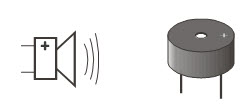To emit sound, the cyber:bot uses a device called a piezoelectric speaker (piezospeaker). This speaker can make different tones depending on the rate of high/low electrical signals it receives. The schematic symbol and part drawing are shown below.

A piezoelectric element is a crystal that changes shape slightly when voltage is applied to it. Applying high and low voltages alternating at a rapid rate causes the crystal to rapidly change shape. The resulting vibration in turn vibrates the air around it, and this is what the ear detects as sound.
Frequency Facts
- The rate or speed at which something changes is said to be its frequency.
- Frequency can be measured in hertz (Hz) which is the number of times a signal repeats itself in one second.
- One kilohertz is one-thousand-times-per-second, abbreviated 1 kHz.
- Every rate of vibration makes a different tone, or pitch.
- The human ear is able to detect frequencies in a range from very low pitch (20 Hz) to very high pitch (20 kHz or 20,000 Hz).
Did you know?
Piezoelectric elements have many uses. As opposed to sending voltage to the piezoelectric element to make it change shape, when force is applied to a piezoelectric element (which impacts its shape), it actually creates voltage.
Some electronic drum sets use piezoelectric elements to detect when, and how hard, a drummer has hit a sensor.
Some barbeque grills have push button lighters that use a piezoelectric element to cause a spark to start the grill. A spring-loaded hammer inside the button impacts a piezoelectric element to generate a small spark.
Piezoelectric elements, depending on their shape and thickness, have a frequency at which they naturally vibrate. This natural vibration can be used to create voltages at set frequencies that function as the clock oscillator for many computers and microcontrollers. If you have ever seen a clock or watch that says “quartz”, there is a piezoelectric quartz crystal inside.
Adapted Wikimedia Commons image "Inside Quartz Crystal Tuning Fork" by Chribbe76 [Public domain]

